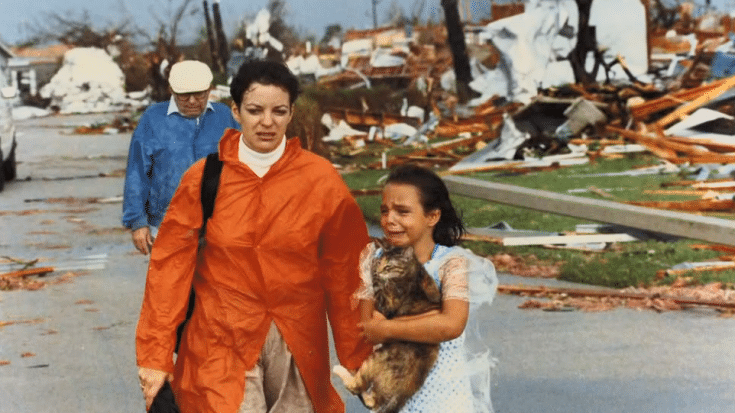8 Environmental Disasters That Marked the 1990s

via Miami Herald / YouTube
The 1990s were a decade of significant technological advancements and cultural shifts. However, this era was also marked by several severe environmental disasters that had lasting impacts on the areas affected and raised global awareness about the importance of emergency preparedness and climate change. From fires and floods to earthquakes and tornadoes, these events tested the resilience of communities and the effectiveness of response strategies. Let’s take a closer look at eight of these occurrences that left a mark on the 1990s.
Oakland Hills Firestorm (1991)
In October 1991, the city of Oakland, California, faced one of the most devastating wildfires in its history. The fire began on a hot, windy day and rapidly spread through the hills, fueled by dry brush and wooden structures. Over 3,000 homes were destroyed, and 25 people lost their lives. This tragedy highlighted the need for better fire safety regulations and more effective emergency communication systems. The community’s effort to rebuild in the aftermath showed the strength and resilience of the residents, but the memory of the firestorm serves as a grim reminder of nature’s power.
Hurricane Andrew Hits Florida (1992)
August 1992 brought one of the most powerful hurricanes ever recorded—Hurricane Andrew. Striking Florida with winds surpassing 165 miles per hour, Andrew leveled entire neighborhoods, particularly in the Homestead area, and caused over $25 billion in damages. Its ferocity led to significant changes in building codes and disaster preparedness plans. Despite the widespread destruction, the recovery efforts showcased the community’s determination to rebuild and led to improved understanding of hurricane impacts.
Great Flood of the Mississippi and Missouri Rivers (1993)
The summer of 1993 was marked by an unprecedented flood that affected the Midwest, with the Mississippi and Missouri rivers swelling beyond their banks. The floodwaters inundated millions of acres of farmland, destroyed thousands of homes, and disrupted the lives of countless individuals. It prompted a reevaluation of flood management strategies and underscored the vulnerability of flood-prone areas. The event brought communities together in the face of adversity and reshaped policies concerning river management and flood prevention.
Northridge Earthquake in California (1994)
Early in the morning of January 17, 1994, a powerful earthquake struck Northridge, a neighborhood in Los Angeles, California. With a magnitude of 6.7, it caused widespread damage to buildings, highways, and infrastructure, leading to the deaths of over 60 people. This earthquake prompted a major overhaul in the engineering standards for buildings and bridges, emphasizing the need for designs that could withstand seismic activities. The rebuilding process was a testimony to the community’s resilience and the importance of prepared emergency responses.
Red River Flood (1997)
In the spring of 1997, the Red River overflowed its banks, causing catastrophic flooding in North Dakota and Minnesota. Thousands of homes were submerged, and cities like Grand Forks saw significant damage. The flood led to an extensive review of flood defenses and the implementation of improved flood protection measures, including enhanced levees and floodways. The disaster emphasized the importance of community and governmental cooperation in facing natural disasters, leading to better-prepared communities.
Salt Lake City Tornado (1999)
On August 11, 1999, an unexpected and rare tornado struck Salt Lake City, Utah, catching residents and authorities by surprise. It caused extensive damage to the downtown area, including the destruction of a historic outdoor shopping mall. The tornado, unusual for the region, led to a reevaluation of emergency planning for natural disasters thought unlikely to occur in certain areas. This incident showed the unpredictable nature of weather phenomena and the need for readiness in all forms.
Agnes Flood Remnants Affect Northeast (1992)
Just weeks after Hurricane Andrew, the remnants of Hurricane Agnes swept through the Northeast in 1992, causing widespread flooding. The floodwaters damaged homes and infrastructure, particularly in Pennsylvania and New York, testing the emergency response systems of the affected states. This event underscored the far-reaching effects of hurricanes and led to improved forecasting and emergency planning for future storms. The Agnes flood remains a stark reminder of the potential impacts of hurricane remnants in areas not typically prone to such events.
Midwest Blizzard (1999)
Closing out the decade, the Midwest experienced a massive blizzard in 1999 that blanketed the region with unprecedented snowfall. Cities were paralyzed, transportation was halted, and emergency services were stretched thin. The blizzard underscored the need for effective snow removal and the importance of winter weather preparedness. Despite the challenges, the event saw communities banding together to clear roads and check on vulnerable neighbors, showcasing the human spirit’s resilience in the face of severe weather conditions.


























